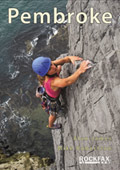|
|
Route |
|---|---|
|
|
51.61127°N / 4.90212°W |
|
|
Trad Climbing |
|
|
Summer, Fall, Winter |
|
|
Less than two hours |
|
|
HS 4a (5.6-5.7 YDS) |
|
|
2 |
|
|
Overview
It's difficult to give a just introduction to a route of this calibre, and even to simply say that Diedre Sud is nothing short of remarkable seems to be unforgivably weak. Just know this, it ascends the entire West Face of the already magnificent Mowing Word, is very steep and satisfyingly exhilarating, has many sublime positions, and might well be the best route of its grade anywhere in Britain – oh what the hell, the world. Diedre Sud represents the fruits of the first explorations of South Pembroke, which were dominated by Colin Mortlock, Lyn Noble and Jim Perrin. This particular route fell to Mortlock on the 30th of May 1967, not the first route on the crag, but almost certainly the best. Today it is a popular attraction for British climbers, and is considered a corner stone in many an aspiring leaders' career. Be aware though, bird restrictions affect this part of Mowing Word and climbing is banned between the 1st of March and 1st of August each year. See the Mowing Word mountain/rock page for more information. |
Getting There
|
Mowing Word lies around midway between Broad Haven Beach and Stackpole Quay, but is best reached from the beach in the south. When approaching from Carmarthen (SN 405 196) take the A40 Truck Road signposted for Saint Clears (SN 274 160). At the Saint Clears roundabout, take the A477 Trunk Road towards Pembroke Dock (SM 969 036). Before reaching Pembroke Dock, turn left onto the A4075 (SN 019 027) to Pembroke (SM 989 012). In Pembroke, drive straight over the first small roundabout you reach and drive along the A4139 a few hundred metres and turn left and take the B4319 south towards Castlemartin (SR 915 983). Around 2.5km after Saint Petrox (SR 971 975), take a left hand turn (SR 965 964) signposting Bosherston (SR 965 947). Drive through Bosherston (or stop for a cup of tea at Mrs Weston's Olde Worlde Café) to the Broad Haven Car Park (SR 975 939). Leave the car park and cross Broad Haven Beach, from here follow a path along a fence that leads to Saddle Bay (SR 983 942). From Saddle Bay follow the coastal path past Raming Hole (SR 987 944) to a small sandy bay. From here you will be able to see the narrow headland of Mowing Word (SR 991 942) protruding far into the sea. The coastal path will now take you along the cliff tops to said headland where you will be provided with a choice of stakes for abseiling and belaying. Choose the small and slightly rusty 'double' stake. At low tide it is possible to reach the base of the crag on foot by abseiling in at Gun Cliff and strolling across the beach. The final push to the start of the route will require a short sea level traverse across the Chimes of Freedom Area. |
Route Description
Anchor your static rope to the small 'double' stake just above the corner that gives the route. Abseil in and establish a hanging belay on ledges just above the high tide mark. Pitch 1 (20m): The only way is up! Follow the steep corner crack on reassuring holds to a series of ledges at around 15 metres. Continue easily up these for another 5 metres or so to a large ledge on the right. Belay here, or climb straight through. If climbing in choppy seas your second won't thank you for climbing on. Pitch 2 (20m): This pitch gives the crux of the climb, which comes in at a surprisingly reasonable 4a. Follow the natural line of the corner to the overhang above, but before reaching it take the large crack to your left. Follow the crack around the overhang to the top and belay your second from the stake used for your abseil. Bring your second up and high fives all round – you've just completed a UK classic! |
Essential Gear
The route is either one long pitch or two short ones - so equip yourself accordingly. The route will take an absolute ton of gear, so if you like to place a lot, take as much as you can carry. Unlike many of Pembroke's climbs, Diedre Sud will take a mixture of small and large gear so be sure to have a good mix. Cams become very useful higher up. You will also need to make allowances for a hanging belay at the start of the route. Double ropes are essential for avoiding rope drag. You should also carry an abseil rope to safely access to the base of the crag, along with a set of prussiks (or equivalent) to allow for self rescue should the need arise. |
Maps
|
| Navigation Maps Ordnance Survey 1:25k Explorer Series OL 36 South Pembrokeshire/De Sir Benfro Ordnance Survey 1:50k Landranger Series 158 Tenby & Pembroke / Dinbych-y-pysgod & Penfro Road Maps |
Guidebooks
|
External Links
 The West Face (Photo by Nanuls) The West Face (Photo by Nanuls) Restriction Markers (Photo by Nanuls) Restriction Markers (Photo by Nanuls)Government Bodies and Other Organisations Pembrokeshire Coast National Park Authority Association of National Park Authorities Royal Commission on Ancient & Historical Monuments in Wales Maritime and Coastguard Agency Outdoor Organisations and Companies British Mountaineering Council Pembrokeshire Outdoor Charter Group Weather and Tides Tourist Information Travel Information Welsh Public Transport Information Accommodation Youth Hostel Association in Wales Maps and Guidebooks
Cordee Travel and Adventure Sports Bookshop Wildlife and Conservation Joint Nature Conservation Committee Royal Society for the Protection of Birds |









